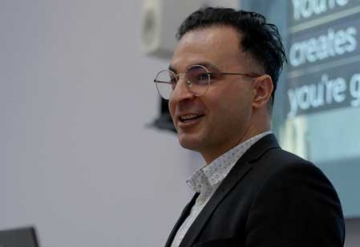THANK YOU FOR SUBSCRIBING

In with the Old: New Toronto through Selective Demolition and Advanced Safety Methods
Matthew Antongiovanni, Green Infrastructure Partners

 Matthew Antongiovanni, Green Infrastructure Partners
Matthew Antongiovanni, Green Infrastructure PartnersOfficially founded in 1834, the City of Toronto has continued to make its mark as Ontario’s capital and as the economic capital of Canada. For centuries, Toronto has continually invested in infrastructure, residential, and business sectors to support its fast-growing population.
As a result of its exponential growth, it is not a surprise to see construction at every corner in the City of Toronto. The city still maintains its dominance in the construction industry by flaunting the most operating tower cranes in all major cities in North America. Along with that growth, Construction Health and Safety has been evolving and has become top priority for the city’s fast growing construction industry.
Selective demolition and partial or full preservation of buildings components or façade have become more common. The historical value of Toronto’s heritage buildings has become a precise and challenging demolition task where health and safety demands have been translated to new heights – from precise demolition plans and accompanying job hazard analysis, to crane planning checklists when removing structural elements, to asbestos removal plans and hundreds of Safe Work Practices to provide guidance to workers to safely perform their tasks.
MacDonald Block Reconstruction - Built in 1971, the 1.7 million square feet
MacDonald Block is home to administrative operations for the government of Ontario and has never experienced a major renovation.
The MacDonald Block Complex consists of four office towers (Hearst, Hepburn, Mowat and Ferguson) located at 900 Bay Street in the City of Toronto. The towers range from 10 to 24 storeys connected by a two-storey podium with two levels of underground parking. The main goal of the project was to re-design and re-invent the complex while preserving heritage elements using modern technologies and materials meeting health, safety and accessibility standards, ultimately accommodating more employees. GIP demolition division was tasked to carry out precise interior demolition while ensuring heritage components including the building envelope and podium structures remained in its original condition.
“Lifting plans, ventilation and dust monitoring, analyzing trending hazards, continuous education of our workforces and monitoring the constantly changing conditions has lead to the successful progress of those historically monumental projects.”
Throughout the life of the project our safety team continuously updated the Project Specific Safety Plan adding new scopes as the project grew and complimented with safe work practices. Air and ventilation monitoring was implemented in multiple areas to ensure the health and safety of all workers. Confined space program was followed for areas that required permits to enter and special emergency rescue plans. Asbestos and lead abatement procedures and enclosures were set up and implemented for the removal process. Remediation and removal of contaminated soil from underground levels was carried with specialized PPE protection, VOC and air monitoring due to contaminants evaporations and equipment fumes in enclosed spaces. Lifting plans were prepared for the lifting activities of transferring heavy equipment to upper floors andeliminating health and safety hazards to personnel by using non-human (remotely) operatedequipment to allow for demolition in particularly hazardous environments. Implemented and built the longest chute to safely remove debris.
The United Bldg. Condos at 481 University Ave - North America’s largest heritage retrofit
Originally built in 1910, 481 University Avenue became the home of MacLean Publishing Company. The reinforced concrete building became the first commercial building on the avenue and the epicenter for news and media in the nation. As MacLean Publishing grew, the need to expand office space and printing facilities did as well. MacLean Publishing continued to expand and eventually took an entire block expanding from University Avenue, Dundas Street, Centre Avenue, and Edward Street.
The United Bldg. Condos became North America’s largest heritage retrofit. GIP was tasked to perform separations between each of the four buildings before work could be done on the heritage structures. Complete structural demolition of two buildings and a shoring system was installed around the perimeter of the entire block to install a grade beam while we also began installing steel supports for exterior retentionusing a grade beam to transfer loads away from the foundation. Once the truss system was installed, demolition began from the back side of the building. The goal was to remove each level while retaining one bay and façade of the 10-storey buildings along University Avenue and Dundas Street, preserving heritage components.Engineered procedures were developed to support heavy equipment while demolishing precast floorsfrom the top down while maintaining control of the materials removed. GIP later installed king piles at the base of the building to allow for the install of the transfer truss system.
Along with the great amounts of work and effort to preserve old Toronto a focus area has emerged - hHealth and safety. We focused on documentation, training, auditing and reducing risk to our teams. Lifting plans, ventilation and dust monitoring, analyzing trending hazards, continuous education of our workforces and monitoring the constantly changing conditions has lead to the successful progress of those historically monumental projects.
Read Also
Development of the Logistics Warehousing Market in Brazil
Driving Innovation and Preserving Tradition
Operational Leadership VS Field Leadership in the Utility Construction Business
People-First Innovation: Developing Virtual Design and Construction (VDC) Training Programs to Empower Field Team Members
Sustainable Projects: Aligning Business and Purpose in Latin America
Engage Smarter: Why Constraints Matter More Than Hazards

 Copyright © 2025 All Rights Reserved | by:
Copyright © 2025 All Rights Reserved | by: Construction Tech Review
| Subscribe | About us | Sitemap| Editorial Policy| Feedback Policy














